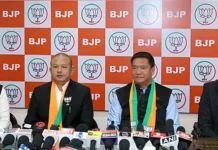[Shamshad Alam]
Formal education is widely recognised as an essential pillar for the development and progress of any society. It lays the foundation for nurturing young minds, enabling them to acquire knowledge, develop critical thinking skills, and contribute meaningfully to the growth of their communities.
However, in the serene landscapes of Arunachal Pradesh, the education system faces numerous challenges that hinder its effectiveness and impact on the state’s overall development.
Arunachal, known as the ‘Land of the Dawn-lit Mountains’, boasts diverse indigenous cultures and breathtaking natural beauty. However, it also faces unique obstacles when it comes to providing quality education to its populace.
One of the primary challenges is the state’s remote geographical location and difficult terrain. With its mountainous terrain and limited connectivity, many areas in Arunachal are isolated, making it challenging to establish and maintain educational institutions.
Infrastructure deficiencies also plague the education system in Arunachal. While the state government has made efforts to construct schools and other educational facilities, there is a lack of adequate infrastructure across the state. Many schools continue to function from dilapidated buildings with insufficient classrooms, libraries, laboratories, and other necessary facilities. This inadequacy adversely affects the learning environment and hampers the efficient delivery of education.
Another critical challenge is the shortage of trained and qualified teachers in the state. Arunachal has been grappling with attracting and retaining highly skilled educators, especially in remote areas. The difficulties associated with geographical location and limited amenities deter many teachers from accepting postings in these regions. Consequently, the dearth of qualified teachers hampers the quality of education, as students are deprived of the guidance and expertise required to excel academically.
Furthermore, the diverse indigenous cultures and languages of Arunachal pose a challenge to the education system. The state boasts over 20 major tribes, each with its distinct language and cultural heritage. While the common language is Hindi, English is the medium of instruction in schools. However, due to limited exposure and resources, many students in remote areas struggle to grasp these languages, hindering their overall education. Moreover, the lack of educational materials and curriculum tailored to the local context further widens the gap between students’ cultural background and the education they receive.
The financial constraints faced by the state government also contribute to the challenges in the education system. Arunachal, like many other states in India, struggles with limited financial resources and allocation towards education. The inadequate funding undermines efforts to improve infrastructure, recruit qualified teachers, and develop innovative teaching methodologies. This financial crunch perpetuates a vicious cycle, preventing the necessary interventions required to uplift the education system.
To address these challenges, a collaborative effort is necessary involving the state government, local communities, and educational stakeholders. Firstly, the government needs to prioritise and allocate adequate funds for education. This would enable the construction of robust infrastructure, recruitment of qualified teachers, and provision of necessary resources. Additionally, the government should focus on creating incentives and support systems to attract and retain teachers, especially in remote areas.
Localisation of the curriculum and teaching materials can play a significant role in addressing cultural gaps. Introducing indigenous languages and traditions into the education system would not only preserve and celebrate the rich cultural heritage of Arunachal but also facilitate a deeper understanding and engagement of students.
Finally, leveraging technology and e-learning platforms can help overcome the geographical barriers and improve access to quality education in remote areas. The use of digital tools and resources can bridge the gap between urban and rural schools and provide equal opportunities for all students.
In conclusion, the education system in Arunachal faces numerous challenges that stem from its geographical isolation, infrastructure deficiencies, shortage of qualified educators, cultural diversity, and limited financial resources. Overcoming these challenges requires a committed effort from the government, local communities, and educational stakeholders. By addressing these obstacles and implementing innovative strategies, Arunachal can strive towards providing quality education to all its residents, ensuring a brighter and prosperous future for the state. (The contributor is founder and CEO of Edunachal Pvt Ltd)




